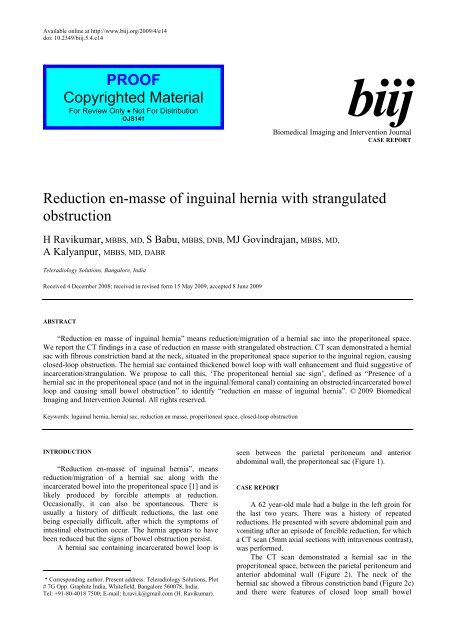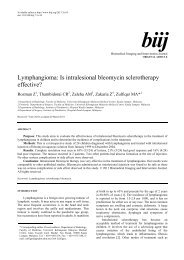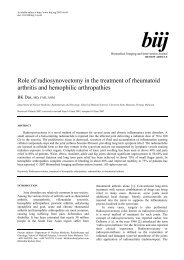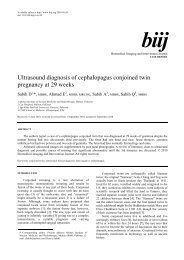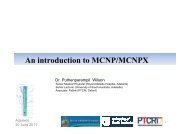Reduction en-masse of inguinal hernia with strangulated obstruction ...
Reduction en-masse of inguinal hernia with strangulated obstruction ...
Reduction en-masse of inguinal hernia with strangulated obstruction ...
Create successful ePaper yourself
Turn your PDF publications into a flip-book with our unique Google optimized e-Paper software.
Available online at http://www.biij.org/2009/4/e14<br />
doi: 10.2349/biij.5.4.e14<br />
biij<br />
Biomedical Imaging and Interv<strong>en</strong>tion Journal<br />
CASE REPORT<br />
<strong>Reduction</strong> <strong>en</strong>-<strong>masse</strong> <strong>of</strong> <strong>inguinal</strong> <strong>hernia</strong> <strong>with</strong> <strong>strangulated</strong><br />
<strong>obstruction</strong><br />
H Ravikumar, MBBS, MD, S Babu, MBBS, DNB, MJ Govindrajan, MBBS, MD,<br />
A Kalyanpur, MBBS, MD, DABR<br />
Teleradiology Solutions, Bangalore, India<br />
Received 4 December 2008; received in revised form 15 May 2009, accepted 8 June 2009<br />
ABSTRACT<br />
PROOF<br />
Copyrighted Material<br />
For Review Only • Not For Distribution<br />
OJS141<br />
“<strong>Reduction</strong> <strong>en</strong> <strong>masse</strong> <strong>of</strong> <strong>inguinal</strong> <strong>hernia</strong>” means reduction/migration <strong>of</strong> a <strong>hernia</strong>l sac into the properitoneal space.<br />
We report the CT findings in a case <strong>of</strong> reduction <strong>en</strong> <strong>masse</strong> <strong>with</strong> <strong>strangulated</strong> <strong>obstruction</strong>. CT scan demonstrated a <strong>hernia</strong>l<br />
sac <strong>with</strong> fibrous constriction band at the neck, situated in the properitoneal space superior to the <strong>inguinal</strong> region, causing<br />
closed-loop <strong>obstruction</strong>. The <strong>hernia</strong>l sac contained thick<strong>en</strong>ed bowel loop <strong>with</strong> wall <strong>en</strong>hancem<strong>en</strong>t and fluid suggestive <strong>of</strong><br />
incarceration/strangulation. We propose to call this, ‘The properitoneal <strong>hernia</strong>l sac sign’, defined as “Pres<strong>en</strong>ce <strong>of</strong> a<br />
<strong>hernia</strong>l sac in the properitoneal space (and not in the <strong>inguinal</strong>/femoral canal) containing an obstructed/incarcerated bowel<br />
loop and causing small bowel <strong>obstruction</strong>” to id<strong>en</strong>tify “reduction <strong>en</strong> <strong>masse</strong> <strong>of</strong> <strong>inguinal</strong> <strong>hernia</strong>”. © 2009 Biomedical<br />
Imaging and Interv<strong>en</strong>tion Journal. All rights reserved.<br />
Keywords: Inguinal <strong>hernia</strong>, <strong>hernia</strong>l sac, reduction <strong>en</strong> <strong>masse</strong>, properitoneal space, closed-loop <strong>obstruction</strong><br />
INTRODUCTION<br />
“<strong>Reduction</strong> <strong>en</strong>-<strong>masse</strong> <strong>of</strong> <strong>inguinal</strong> <strong>hernia</strong>”, means<br />
reduction/migration <strong>of</strong> a <strong>hernia</strong>l sac along <strong>with</strong> the<br />
incarcerated bowel into the properitoneal space [1] and is<br />
likely produced by forcible attempts at reduction.<br />
Occasionally, it can also be spontaneous. There is<br />
usually a history <strong>of</strong> difficult reductions, the last one<br />
being especially difficult, after which the symptoms <strong>of</strong><br />
intestinal <strong>obstruction</strong> occur. The <strong>hernia</strong> appears to have<br />
be<strong>en</strong> reduced but the signs <strong>of</strong> bowel <strong>obstruction</strong> persist.<br />
A <strong>hernia</strong>l sac containing incarcerated bowel loop is<br />
* Corresponding author. Pres<strong>en</strong>t address: Teleradiology Solutions, Plot<br />
# 7G Opp. Graphite India, Whitefield, Bangalore 560078, India.<br />
Tel: +91-80-4018 7500; E-mail: h.ravi.k@gmail.com (H. Ravikumar).<br />
se<strong>en</strong> betwe<strong>en</strong> the parietal peritoneum and anterior<br />
abdominal wall, the properitoneal sac (Figure 1).<br />
CASE REPORT<br />
A 62 year-old male had a bulge in the left groin for<br />
the last two years. There was a history <strong>of</strong> repeated<br />
reductions. He pres<strong>en</strong>ted <strong>with</strong> severe abdominal pain and<br />
vomiting after an episode <strong>of</strong> forcible reduction, for which<br />
a CT scan (5mm axial sections <strong>with</strong> intrav<strong>en</strong>ous contrast),<br />
was performed.<br />
The CT scan demonstrated a <strong>hernia</strong>l sac in the<br />
properitoneal space, betwe<strong>en</strong> the parietal peritoneum and<br />
anterior abdominal wall (Figure 2). The neck <strong>of</strong> the<br />
<strong>hernia</strong>l sac showed a fibrous constriction band (Figure 2c)<br />
and there were features <strong>of</strong> closed loop small bowel
H Ravikumar et al. Biomed Imaging Interv J 2009; 5(4):e14 2<br />
This page number is not<br />
for citation purposes<br />
<strong>obstruction</strong>. The <strong>hernia</strong>l sac contained thick<strong>en</strong>ed bowel<br />
loop <strong>with</strong> wall <strong>en</strong>hancem<strong>en</strong>t and fluid suggestive <strong>of</strong><br />
incarceration and strangulation (Figures 2c, 2d, and 2e).<br />
The pati<strong>en</strong>t was operated on and the <strong>hernia</strong>l sac was<br />
found to contain ischemic small bowel loop, which was<br />
resected and <strong>en</strong>d-to-<strong>en</strong>d anastomosis was performed.<br />
DISCUSSION<br />
Figure 1 (a) Diagram <strong>of</strong> <strong>inguinal</strong> <strong>hernia</strong> at the site <strong>of</strong> <strong>inguinal</strong> ring. (b) Diagram <strong>of</strong> reduction <strong>en</strong> <strong>masse</strong> - A <strong>hernia</strong>l<br />
sac is se<strong>en</strong> containing incarcerated bowel loop betwe<strong>en</strong> the parietal peritoneum and anterior abdominal<br />
wall, the properitoneal sac.<br />
<strong>Reduction</strong> <strong>en</strong>-<strong>masse</strong> <strong>of</strong> <strong>inguinal</strong>/femoral <strong>hernia</strong> can<br />
be defined as reduction <strong>of</strong> the <strong>hernia</strong>l sac together <strong>with</strong><br />
its intestinal cont<strong>en</strong>ts so that the bowel still remains<br />
incarcerated [2]. It is a rare form <strong>of</strong> acute intestinal<br />
<strong>obstruction</strong> that few surgeons get to see and <strong>with</strong> which<br />
many radiologists are unfamiliar. It has be<strong>en</strong> quoted by<br />
Pearse to occur in approximately 1 <strong>of</strong> 13,000 <strong>hernia</strong>s [3].<br />
<strong>Reduction</strong> <strong>en</strong>-<strong>masse</strong> <strong>of</strong> <strong>hernia</strong> is quite rare as a result<br />
<strong>of</strong> early repair <strong>of</strong> <strong>hernia</strong>s and abandonm<strong>en</strong>t <strong>of</strong> forcible<br />
reduction [4]. Most unusual are the spontaneous<br />
reductions that have be<strong>en</strong> docum<strong>en</strong>ted.<br />
Clinically, a t<strong>en</strong>der mass can be palpated either high<br />
in the <strong>inguinal</strong> canal, above the <strong>inguinal</strong> ring or in the<br />
lower abdom<strong>en</strong>, on the side <strong>of</strong> reduction. Early surgical<br />
interv<strong>en</strong>tion is necessary as prognosis is not always good<br />
due to the delay in time from onset <strong>of</strong> symptoms and<br />
surgery, more so in spontaneous reductions.<br />
Cast<strong>en</strong> and Bod<strong>en</strong>heimer postulated that reduction<br />
<strong>en</strong> <strong>masse</strong> can occur only if there is a relatively<br />
unyielding neck <strong>of</strong> the sac and a lax internal ring [5].<br />
Fibrosis is probably produced by recurr<strong>en</strong>t trauma from<br />
difficult reductions. Pearse concluded that a preformed<br />
space betwe<strong>en</strong> the parietal peritoneum and anterior<br />
abdominal wall, the properitoneal sac, or diverticulum<br />
was pres<strong>en</strong>t in many cases, while Millard suggested that<br />
such a sac was equally likely to be produced by forcible<br />
attempts at reduction [6]. There is usually a history <strong>of</strong><br />
difficult reductions, the last being more difficult, after<br />
which the symptoms <strong>of</strong> intestinal <strong>obstruction</strong> fail to<br />
subside or subside only temporarily [7, 8].<br />
In the above case, the bowel, along <strong>with</strong> <strong>hernia</strong>l sac,<br />
would appear to have be<strong>en</strong> pushed back into the<br />
properitoneal space by repeated reductions. We propose<br />
to call this, ‘The properitoneal <strong>hernia</strong>l sac sign’, defined<br />
as “Pres<strong>en</strong>ce <strong>of</strong> a <strong>hernia</strong>l sac in the properitoneal space<br />
(and not in the <strong>inguinal</strong>/femoral canal) containing an<br />
obstructed/incarcerated bowel loop and causing small<br />
bowel <strong>obstruction</strong>” to id<strong>en</strong>tify “<strong>Reduction</strong> <strong>en</strong> <strong>masse</strong> <strong>of</strong><br />
<strong>hernia</strong>e”. The properitoneal space may have be<strong>en</strong> preformed<br />
by similar past incid<strong>en</strong>ts and later on,<br />
developm<strong>en</strong>t <strong>of</strong> fibrosis at the neck <strong>of</strong> sac may have<br />
caused small bowel <strong>obstruction</strong>.<br />
We were unable to provide details <strong>of</strong> the MDCT or<br />
intra-operative images as ours is a teleradiology service.<br />
Despite its numerous advantages, the expansion <strong>of</strong><br />
telemedicine may pose an increasing chall<strong>en</strong>ge to<br />
collaboration, research and expansion <strong>of</strong> medical<br />
knowledge unless measures are put in place to overcome<br />
them.<br />
In summary, reduction <strong>en</strong>-<strong>masse</strong> <strong>of</strong> <strong>inguinal</strong> <strong>hernia</strong><br />
is a clinical diagnosis which can be confirmed by CT.<br />
<strong>Reduction</strong> <strong>en</strong>-<strong>masse</strong> <strong>of</strong> <strong>hernia</strong> should be considered as a<br />
cause <strong>of</strong> acute intestinal <strong>obstruction</strong> in pati<strong>en</strong>ts <strong>with</strong><br />
persist<strong>en</strong>t bowel <strong>obstruction</strong> following reduction <strong>of</strong><br />
<strong>inguinal</strong>/femoral <strong>hernia</strong>s. The proposed ‘properitoneal<br />
<strong>hernia</strong>l sac sign’ helps in id<strong>en</strong>tifying and confirming
H Ravikumar et al. Biomed Imaging Interv J 2009; 5(4):e14 3<br />
This page number is not<br />
for citation purposes<br />
(a) (b)<br />
(c) (d)<br />
(e)<br />
Figure 2 (a) CT scan <strong>of</strong> the abdom<strong>en</strong> demonstrating dilated small bowel loops suggestive <strong>of</strong> bowel <strong>obstruction</strong>.<br />
(b) The <strong>hernia</strong>l sac [arrow] containing thick<strong>en</strong>ed bowel loop and mes<strong>en</strong>teric fat [arrowhead] is se<strong>en</strong> in<br />
the properitoneal space, superior to the left <strong>inguinal</strong> region. (c) A fibrous constriction band is se<strong>en</strong><br />
around the neck <strong>of</strong> the <strong>hernia</strong>l sac [arrow] .Note <strong>en</strong>hancem<strong>en</strong>t <strong>of</strong> bowel wall [arrowhead]. (d) The<br />
inferior aspect <strong>of</strong> the <strong>hernia</strong>l sac containing bowel [arrow]. (e) Fluid in the <strong>hernia</strong>l sac [arrow]. Wall<br />
<strong>en</strong>hancem<strong>en</strong>t <strong>of</strong> the bowel loop and fluid in the <strong>hernia</strong>l sac suggest incarceration and strangulation.
H Ravikumar et al. Biomed Imaging Interv J 2009; 5(4):e14 4<br />
This page number is not<br />
for citation purposes<br />
“reduction <strong>en</strong>-<strong>masse</strong> <strong>of</strong> <strong>hernia</strong>”, likely to be produced by<br />
forcible attempts at reduction. Rarely, it can also occur<br />
spontaneously, where the prognosis is bad.<br />
REFERENCES<br />
1. Masahiro K, Takayuki Y, Tadashi I et al. CT findings <strong>of</strong><br />
“reduction <strong>en</strong> <strong>masse</strong>” <strong>of</strong> an <strong>inguinal</strong> <strong>hernia</strong>. European Journal <strong>of</strong><br />
Radiology Extra 2008; 67(3):e111-4.<br />
2. Louis SP, Elliot H, Jack R. Spontaneous reduction <strong>of</strong> <strong>hernia</strong> “<strong>en</strong><br />
<strong>masse</strong>”. AJR Am J Ro<strong>en</strong>tg<strong>en</strong>ol 1974; 121(2):252-5.<br />
3. Pearse HE. Strangulated <strong>hernia</strong> reduced “<strong>en</strong> <strong>masse</strong>”. Surg Gynec<br />
Obstet 1931; 53:822-8.<br />
4. R<strong>en</strong>ton CJ. <strong>Reduction</strong> <strong>en</strong> <strong>masse</strong> <strong>of</strong> direct <strong>inguinal</strong> <strong>hernia</strong>. Br Med J<br />
1962; 1(5293):1671.<br />
5. Cast<strong>en</strong> D, Bod<strong>en</strong>heimer M. Strangulated <strong>hernia</strong> reduction <strong>en</strong> <strong>masse</strong>.<br />
Surgery 1941; 9:561-6.<br />
6. Millard AH. Auto-reduction '<strong>en</strong> <strong>masse</strong> <strong>of</strong> an <strong>inguinal</strong> <strong>hernia</strong>.<br />
Postgrad Med J 1955; 31(352):79-80.<br />
7. Wolfe HRI. Strangulation <strong>of</strong> an <strong>inguinal</strong> <strong>hernia</strong> from autoreduction<br />
<strong>en</strong> <strong>masse</strong>. Brit J Surg 1939; 27(106):421-3.<br />
8. Bailie RW. Auto-reduction <strong>en</strong> <strong>masse</strong> <strong>of</strong> an <strong>inguinal</strong> <strong>hernia</strong>.<br />
Postgrad Med J 1953; 29(332):323-5.


